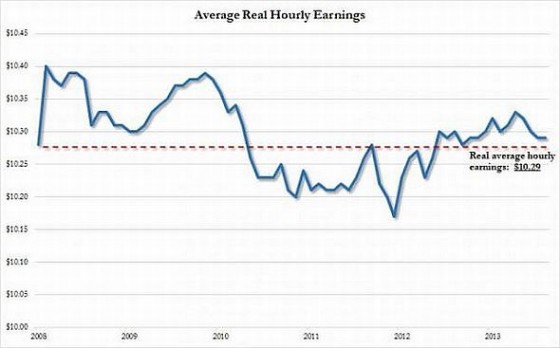“The idea that you can change one input in an interconnected system of systems and only affect the one output you want is not just naive and simplistic: it requires a level of blindness and incompetence that is off the charts.” C H Smith
 Just as the Federal Reserve cannot directly force you to stick the needle of monetary heroin (debt) into your arm, it also can’t force employers to pay employees more.
Just as the Federal Reserve cannot directly force you to stick the needle of monetary heroin (debt) into your arm, it also can’t force employers to pay employees more.
The official policy of the Central Bank (Federal Reserve)/government is: inflation is necessary for “growth,” i.e. economic expansion. The unstated reason for this official support of inflation is that it’s easier for borrowers to service their debts as their income inflates.
To take an extreme example: let’s say a homeowner has a mortgage of $100,000, an annual wage of $40,000 and annual mortgage payments of $10,000. At 100% annual inflation in both prices and wages, the home mortgage remains fixed at $100,000, the payment remains fixed at $10,000 but his earnings double to $80,000.
Where the mortgage payment initially took 25% of his earnings, now it only takes 12.5%. Yippee Skippy, the homeowner has an “extra” 12.5% of his earnings to support more consumption and debt: thanks to inflation, the homeowner can now buy a car on credit and use the “extra” 12.5% of earnings to pay the auto loan.
Central banks around the world seek inflation for another reason: the Keynesian Cargo Cult that dominates all central banks and governments believes with quasi-religious certainty that people respond to inflation by buying more stuff now rather than later: since prices will rise in the future, it makes sense to buy stuff now at “lower prices compared to next year’s prices.”
This is called bringing demand forward, as the demand to buy stuff is shifted from the future to the present.
In an economy dependent on debt-based consumption, inflation is absolutely essential to reduce the real costs of servicing old debts so households can afford to buy more stuff on credit. This is the basis of the Fed’s insistence that inflation is equivalent to “growth”–inflation enables households to continue adding more debt to buy more stuff, as long as earnings inflate along with prices.
There are three problems with the Fed’s “inflation is growth” scenario:
1. Earned income (wages and salaries) don’t inflate along with prices
2. Rising inflation and low interest rates crimp lender profits and increase risks
3. Bringing demand forward exhausts households’ ability to fund additional consumption with debt.
To date, all the Fed’s efforts to generate inflation have bypassed earned income: wages and salaries have declined when adjusted for inflation. Hourly wages: stagnant since 2008.

source: Rising Wages Where? Real Wages Post First Annual Decline Since 2012
Real household income has declined across the entire income spectrum:
